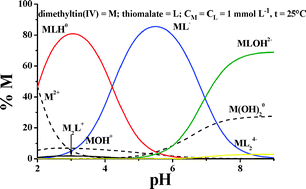Potentiometric, 1H NMR and ESI-MS investigation on dimethyltin(iv) cation–mercaptocarboxylate interaction in aqueous solution†
Abstract
The interaction between

* Corresponding authors
a
Dipartimento di Chimica Inorganica, Chimica Analitica e Chimica Fisica, Università di Messina, Salita Sperone 31, Villaggio S. Agata, 98166 Messina, Italy
E-mail:
ssammartano@unime.it
Fax: 0039090392827
b Dipartimento di Chimica, Università della Calabria, Via P. Bucci, 87036 Arcavacata di Rende, Italy
The interaction between

 Please wait while we load your content...
Something went wrong. Try again?
Please wait while we load your content...
Something went wrong. Try again?
P. Cardiano, O. Giuffrè, A. Napoli and S. Sammartano, New J. Chem., 2009, 33, 2286 DOI: 10.1039/B908114C
To request permission to reproduce material from this article, please go to the Copyright Clearance Center request page.
If you are an author contributing to an RSC publication, you do not need to request permission provided correct acknowledgement is given.
If you are the author of this article, you do not need to request permission to reproduce figures and diagrams provided correct acknowledgement is given. If you want to reproduce the whole article in a third-party publication (excluding your thesis/dissertation for which permission is not required) please go to the Copyright Clearance Center request page.
Read more about how to correctly acknowledge RSC content.
 Fetching data from CrossRef.
Fetching data from CrossRef.
This may take some time to load.
Loading related content
